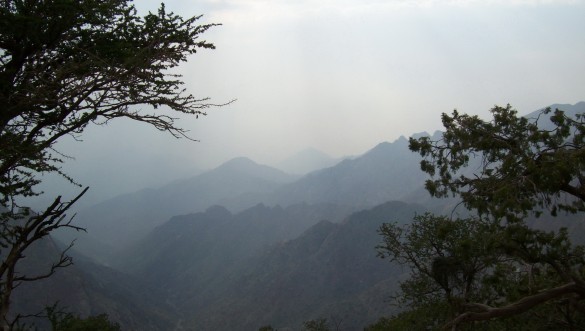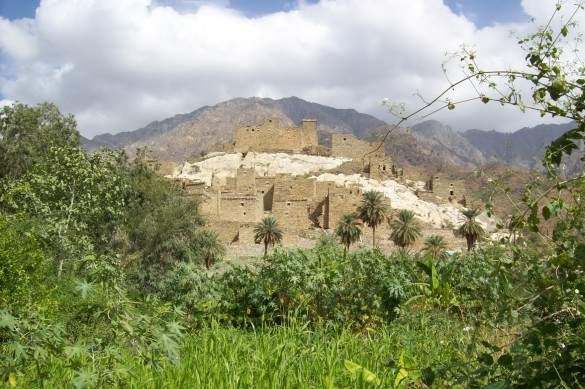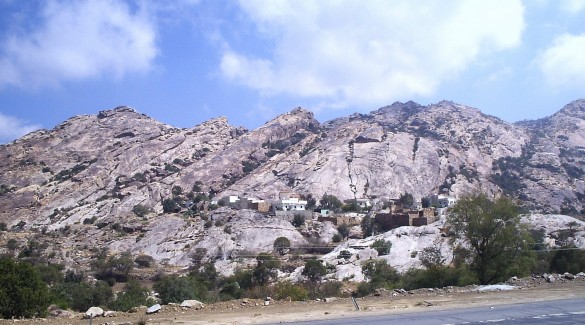To most people, Saudi Arabia is a big sea of sand with waves of dunes and islands of refreshing oases. They would hardly imagine a land of soaring mountain peaks covered with trees and hugged by clouds. But that is exactly the Arabia we found during our 4-day excursion to Abha in the southwestern region of the country.
We set off from Jeddah and traced the road to Makkah. About half an hour on we reached a police checkpoint where they check residence cards or passports. Non-Muslims are directed away from Makkah, Islam’s holiest shrine. At this point we turned right to the road that goes up to Taif.
Here the plain desert landscape begins to transform. On both sides of the road are huge boulders and rocks scattered as in a vast rock garden. Visible in the horizon are silhouettes of jagged peaks in exciting shapes. What is one to say about the shape of a reclining woman with her head and breast tilted upwards, or a phallus pointing to the sky? (Ooops, I beg your pardon.)

The climb to Taif through a steep zigzagging road was difficult but the invigorating cool air that met us at this country’s summer capital was a worthy reward. Past the city proper the road forks and we didn’t know how to go. An attendant at a nearby gas station pointed us to the new road which he said is the shorter route. But we saw the sign “Taif-Baha Tourist Road” on the other narrower road and we decided against his advice.
In a few minutes we were sandwiched between parched hills. A village, actually a cluster of few stone cottages here and there, sits on the valley amidst farm plots. Some plots are green with crops but, as summer had just ended, most lay barren and brown. Given the pastoral scenery I knew that we had taken the right turn.
The road is littered with such villages. More pleasing to this history buff, the road is also littered with ruins of Ottoman forts perched on high grounds. Their appearance in frequent succession suggested to me the importance of this route in days gone by. In my mind I saw camel caravans laden with incense and spices from southern Arabia on their way to the north.
After six hours of leisurely drive with stops for taking pictures, we arrived at the famous resort city of Al Baha. The highway cuts through its center for a stretch of about a kilometer only that we passed it without realizing it. At the last shop on the edge of the city center we were told to go back. We did and stayed to explore the city and to spend the night.

In Al Baha green mountains meet the eyes wherever one looks. From some websites we earlier gathered that the city takes pride in its many forests and some waterfalls. A kind resident suggested we see the popular Raghdan Forest. We climbed the hill to which he directed us but we could not find anything that resembles a forest as we know it in our own tropical country. I asked two men in native costume who were having tea beside a car by the roadside: It’s just a little farther but please come down and have tea with us. It didn’t feel right to decline such hospitality typical of the Saudis that I had to make a promise to be broken that we would join them on our return. I looked up to the hills in front us and I could see clusters of new houses here and there but still there was no sign of the forest. When I saw a man passing by I asked again. “That is Raghdan,” he said, pointing to the thick “bushes” behind us. Actually, as we would find out later, this whole hilly area is called Raghdan.
Quite disappointed, we went back to the city center to ask about the Al Kharrara Waterfall. One inquiry led us to a decorative water fountain in a corner of the shopping district. It must be the language barrier. After more negative responses we found a native who speaks English fluently. “Yes, the waterfall!” he uttered with obvious delight. “We call it ‘shalal’ in Arabic. But you will not find it now. No rain, no waterfall.” Oooh!
That evening it did rain; they said it’s the first after the long summer. By twilight thick clouds descended upon the city. The rain followed quickly and stopped as quickly. It was a good rain but I guess not good enough to make a waterfall.
After breakfast it was on with the journey. Driving through the silk-smooth road
was a joy. The road winds gracefully up and down the hills and valleys of the Sarawat mountain range. It passes through scenic villages, towns and cities, and affords travelers some of the most magnificent mountain views.
In town after town and village after village, houses in the old style but made of modern materials greeted us. Their colors would make one salivate: cotton candy pink, cream, peach, lime, mint, melon, yam, and pomegranate. Ice cream and cakes come to mind. Now and then amidst a field of pastel colors comes a shocking pink or a dark purple. Some villages appear to rise from the ruins of old ones. In Tanouma town, a cluster of cottages appear like matchboxes perched on a huge mountain of solid rock.
Six hours later and we were in the city of Abha, the capital of Asir, as the southwestern region of Saudi Arabia is called. It is a city on a mountain caressed by mist. Had there been a view of the sea it would have embodied my dream city.
Still the beauty of this region is outstanding: steep mountains, lush greenery, and cool breezes year-round. Tor Eigeland wrote of Asir in Aramco World: “This green, mostly mountainous region is God’s own country… Asir is as close to Shangri-la as anything I have seen.” It is inhabited by what the explorer Wilfred Thesiger described as a “graceful, laughing people”.
After seeing some of Abha’s natural attractions I could not but agree.
A village clinging to the cliffs in a 600-foot-deep gorge is incredible. It is aptly called the hanging village of Habala. From the peak of Al Souda 3100m above sea level the sight of mountain ridges that seem endless is spectacular. I thought this is what the explorer H. St. John Philby called “the very backbone … of Arabia.”

To see more of the region some locals advised us to take the road to Jazan on our return to Jeddah. The road is easy to miss and we did so twice. A short narrow street that branches from a bigger road leads to its entrance, which is like an opening made by cutting through the rocky hill. The street appears to end there because beyond it we could only see a cloudy sky. But upon reaching the entrance what we saw left us all open-mouthed: mountain ridges that plunge as deep and as far as the eyes can see, walls of rock, jagged peaks, tumbled boulders, gorges and abysses
This unexpected sight really took our breath away. The experience of gliding in the ridges amid floating clouds was so exhilarating; it was like flying and floating in a heaven-like surrounding. Ah, here is Shangri-la indeed.